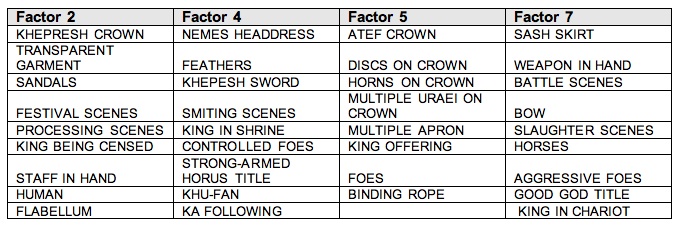There are two primary advanced statistical techniques that have already been applied to selected data from Medinet Habu—factor analysis and cluster analysis. This post will endeavor to explain the insights provided by factor analysis in the examination of visual material. This will not be an article on how to perform the calculations. Remember, you don’t have to understand how to perform an analysis; merely understanding the output of the analysis can provide powerful insights.
Factor analysis, as defined by a statistician: A statistical procedure designed to take a larger number of constructs (measures of some sort) and reduce them to a smaller number of factors that describe these measures with greater parsimony.
Factor analysis, as defined by me, the non-statistician, with help from a statistician:
Factor analysis is simply a way to take a large set of variables and see where sub-groups exist.
For example, political pollsters track an insane number of variables, but their analysis is heavily aided by looking at results based on factor groupings such as gender, race, age, income level, education level, and religious affiliation; these factors would provide far more insight than simply knowing who won a political race, as knowledge of factors provides insights into the why behind the what.
How the Art of Counting uses Factor Analysis
Among the hundreds of variables being tracked at Medinet Habu, performing a factor analysis allowed us to see where groups of variables tended to appear together. For example, here are 4 of the groups suggested by a factor analysis of the Medinet Habu data:
If you are even remotely knowledgeable about ancient Egyptian royal iconography, you will recognize some patterns apparent in the above factors. Factor 2, with the khepresh (‘Blue’) crown, enveloping garment, sandals, staff in the king’s hand, and flabellum (sunshades), is connected to festival scenes and public appearances. Factor 4 has many variables related to smiting scenes, such as the sword, controlled (i.e. grasped in the hand/under foot versus bound) foes, and the ‘Strong-armed Horus’ title. Factor 5 is particularly connected to the scenes where pharaoh offers bound prisoners and battle spoil to the gods—he very often wears a crown with added discs, horns, and multiple uraei (cobras) along with a multiple apron in these venues. Factor 7 includes many of the variables connected with slaughter scenes, including the aggressive foes, a weapon in the king’s hand, and ‘Good God’ title.
It is important to keep in mind that these factor groupings were NOT made by the trained eye, but were instead directly extracted from the data itself. Although there are some questions that emerge regarding certain variables (why exactly the nemes headdress is included in Factor 4, for example), the results of a factor analysis provide an excellent springboard for further investigation.
These groupings would be similar to a factor analysis of your own wardrobe. Imagine that each sock, shoe, shirt, jacket, scarf, belt, necklace, bracelet, pair of pants, pair of shorts, and ring you own were individual variables. You would likely find that certain items tend to go together based on activity and season. There are jackets that would not be worn in the summer and shorts that would not be worn in the winter. However, some items, such as light jackets, would be difficult to consistently group by season, due to the nature of transitional seasons (fall and spring). Some of the jacket items might be very activity, rather than season, specific; if you’ve ever gone to a movie theater in the southern US in the summer, you know that many people bring a light jacket to deal with the ridiculous level of air conditioning. This would make ‘light jackets’ act in ways not seen with other items of clothing. All together, others could make very educated guesses about what you were doing and when based solely on what you were wearing.
Likewise, royal iconography will have some groupings based on activity, others on context, and possibly others based on variables not yet being tracked. Just like ‘going to a movie theater in the southern US in the summer’ creates special behaviors for ‘light jacket’, there would have been special circumstances that would have created unusual variable behavior with royal iconography, perhaps suggesting an explanation for the presence of the nemes in the smiting-centered Factor 4. This is why the master variable list is never considered complete—it will continue to grow for years to come.
Factor analysis is a very useful tool for the examination of visual material. It can quickly illuminate variables that the data suggests may be interconnected in some way and identifies a path for the knowledgeable researcher to proceed upon.




What a great way to describe Factor Analysis! Love the movie theater analogy. The example shown in this post comes from the initial findings of Exploratory Factor Analysis. This type of analysis is usually the first step taken when there’s no prior knowledge about the data. When data are collected from multiple images, there are lots of scenarios and variables. Associations exist among the different variables and it’s our job to find out what these associations are. The findings here are not absolute. As Amy mentioned, it provides new ideas for future investigation. Once we feel comfortable about the grouping of variables, we can further our analysis by confirming the factor structure. This type of analysis is called Confirmatory Factor Analysis. Factor Analysis is truly an art by itself. Proper usage of this type of advanced statistical analysis can provide enormous information for researchers.